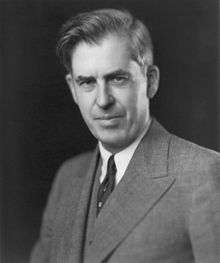Federal Surplus Relief Corporation
| Agency overview | |
|---|---|
| Formed | Charter granted by State of Delaware, October 3, 1935 |
| Superseding agency |
|
| Parent department | United States Department of Agriculture |
| Parent agency | Farm Credit Administration, Agricultural Adjustment Administration |
The Federal Surplus Relief Corporation was one of the so-called alphabet agencies set up in the United States during the early 1930s as part of President Franklin D. Roosevelt's New Deal.
The corporation was merged into other government departments during World War II. As of 2012, the Federal purchase and distribution of surplus food still continues, now under the auspices of the Emergency Food Assistance Program.
History

In summer 1933, the Agricultural Adjustment Administration tried to boost the wholesale price of agricultural produce through an artificial scarcity initiative, in which crops were plowed up or left to rot and six million pigs were killed and discarded.[1] The public outcry over this waste of resources led to the October 1933 establishment of the Federal Surplus Relief Corporation, which aimed to divert commodities such as apples, beans, canned beef and cotton to local relief organizations.[2] In December 1933, the agency distributed three million tons of coal to the unemployed of Wisconsin, Minnesota, Michigan, North Dakota, South Dakota and Iowa [3] and in September 1934 shipped 692,228,274 pounds of foodstuffs to the unemployed in thirty US states.[4]
On November 18, 1935, its name was changed to the Federal Surplus Commodities Corporation, and the Secretary of Agriculture, Henry A. Wallace at that time, the head of the Agricultural Adjustment Administration, and the governor of the Farm Credit Administration were placed on its board of directors.[5]
The Federal Surplus Commodities Corporation was the first federal contribution to the school lunch programs and the first step toward the national school lunch program. In March 1937, there were 3,839 schools receiving commodities for lunch programs serving 342,031 children daily. Two years later, the number of schools participating had grown to 14,075 and the number of children had risen to 892,259.[6]
The Federal Surplus Commodities Corporation was continued as an agency under the secretary of agriculture by acts of June 28, 1937 (50 Stat. 323) and February 16, 1938 (52 Stat. 38). The agency was consolidated with Division of Marketing and Marketing Agreements into Surplus Marketing Administration by Reorg. Plan No. III of 1940, then merged into Agricultural Marketing Administration by Executive Order 9069 of February 23, 1942.
After World War II, the Federal purchase and distribution of food services continued. In the 1960s, counties began to cease distributing the surpluses direct to low income individuals, instead providing an early form of food stamp.[7] Since 1990, the main program responsible for the distribution of surpluses has been the Emergency Food Assistance and Soup Kitchen-Food Bank Program . In the 1980s, the program was called the Temporary Emergency Food Assistance Program. It is now often referred to as the Emergency Food Assistance Program and is administrated by the USDA. As of 2012, surpluses are still distributed, though to food banks and other emergency food agencies, not directly to individuals.[8]
See also
References
- ↑ Heinemann, R. L. (1983). Depression and New Deal in Virginia: The Enduring Dominion. University of Virginia Press. p. 107. ISBN 9780813909462.
- ↑ "Timeline: Surviving the Dust Bowl, 1931–1939". American Experience. PBS. Retrieved 2012-03-02.
- ↑ "Coal Ordered for Needy". NY Times. Retrieved 2012-03-02. (subscription required)
- ↑ "Relief Foods Total 692,228,274 Pounds". NY Times. 1934-10-18. Retrieved 2013-09-20. (subscription required)
- ↑ Betters, P. V.; Williams, J. K.; Reeder, S. L. (1978). Cities and the 1936 Congress. Arno Press. pp. 85–86. ISBN 0405104782. LCCN 77074929.
- ↑ Gunderson, G. W. (2013-01-29). "The National School Lunch Program - Background and Development". USDA Food and Nutrition Service.
- ↑ Poppendieck, J. (1999). "Introduction, Chapter 1". Sweet Charity: Emergency Food and the End of Entitlement. Penguin. ISBN 0140245561.
- ↑ Bello, M. (2012-09-09). "Food banks run short as federal government hands out less". USA TODAY.